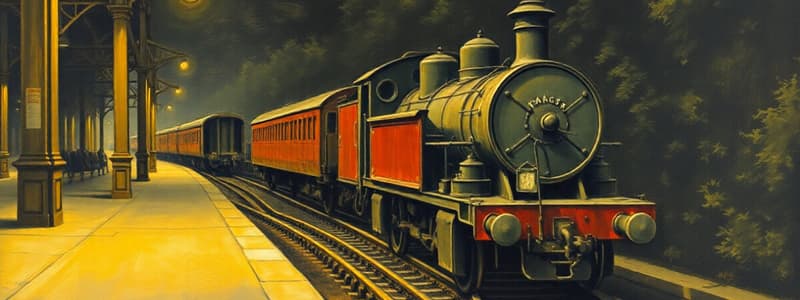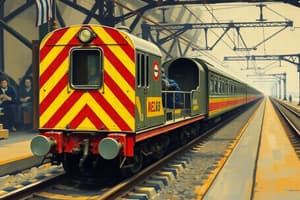Podcast
Questions and Answers
What is a primary factor that affects the tamping frequency of railway tracks?
What is a primary factor that affects the tamping frequency of railway tracks?
- Track geometry, including gradients and curvature (correct)
- Presence of adjacent highways
- Number of railway workers available
- Cost of materials used
Which of the following best describes the general guideline for tamping frequency?
Which of the following best describes the general guideline for tamping frequency?
- Every two years
- Only when tracks show visible damage
- One year and above (correct)
- Less than six months
What should be done if the tamping of a track has bad formation?
What should be done if the tamping of a track has bad formation?
- Replace the entire track segment immediately
- Initiate spot attention for more frequent tamping (correct)
- Conduct tamping less frequently than normally required
- Ignore it until the next scheduled check-up
Who is responsible for approving the frequency of tamping for different rail sections?
Who is responsible for approving the frequency of tamping for different rail sections?
What local conditions can influence the requirement for tamping frequency?
What local conditions can influence the requirement for tamping frequency?
Who is responsible for the overall control of track machines in a Zonal Railway?
Who is responsible for the overall control of track machines in a Zonal Railway?
What is the frequency with which the Senior Divisional Engineer must send the requirement plan to the Chief Engineer/Track Machines?
What is the frequency with which the Senior Divisional Engineer must send the requirement plan to the Chief Engineer/Track Machines?
For how long is the requirement plan prepared starting from 1st April of the coming year?
For how long is the requirement plan prepared starting from 1st April of the coming year?
What does the annual program consist of?
What does the annual program consist of?
Which of the following factors is NOT taken into consideration when drawing the program for track machines?
Which of the following factors is NOT taken into consideration when drawing the program for track machines?
Who fixes the annual targets for each type of machine?
Who fixes the annual targets for each type of machine?
Which of the following is included in the considerations for the requirement plan?
Which of the following is included in the considerations for the requirement plan?
What is one of the focus areas when preparing deployment strategies for track machines?
What is one of the focus areas when preparing deployment strategies for track machines?
What is the minimum clean ballast cushion required on the main line before deploying tamping machines?
What is the minimum clean ballast cushion required on the main line before deploying tamping machines?
Which of the following track geometry standards is crucial before deploying track machines?
Which of the following track geometry standards is crucial before deploying track machines?
Who is responsible for directing the joint inspection of track before the deployment of track machines?
Who is responsible for directing the joint inspection of track before the deployment of track machines?
What must be ensured regarding the track before deploying tamping machines?
What must be ensured regarding the track before deploying tamping machines?
What is the role of Dy.CE(C) in relation to track geometry certification?
What is the role of Dy.CE(C) in relation to track geometry certification?
What tool should be used for recording achieved track parameters during lining/levelling?
What tool should be used for recording achieved track parameters during lining/levelling?
Which factor is NOT listed as a prerequisite for deploying track tamping machines?
Which factor is NOT listed as a prerequisite for deploying track tamping machines?
What should be done if there are deficiencies found during the joint inspection?
What should be done if there are deficiencies found during the joint inspection?
Why are the specified track geometry standards not considered safety tolerances?
Why are the specified track geometry standards not considered safety tolerances?
What is required for proper recording of levels before deploying machines?
What is required for proper recording of levels before deploying machines?
What does Actual Block Hours (ABH) represent?
What does Actual Block Hours (ABH) represent?
How is machine utilization expressed?
How is machine utilization expressed?
What is one condition for regular traffic blocks on a single line section?
What is one condition for regular traffic blocks on a single line section?
In case of a double line section, how many hours is a single spell allowed?
In case of a double line section, how many hours is a single spell allowed?
What should be planned for construction projects and multiple lines?
What should be planned for construction projects and multiple lines?
What defines a mega block running into several days or weeks?
What defines a mega block running into several days or weeks?
Which document or guideline influences the planning of special blocks?
Which document or guideline influences the planning of special blocks?
What is recommended for the temporary conversion when conducting mega blocks?
What is recommended for the temporary conversion when conducting mega blocks?
What does the availability of track machine indicate?
What does the availability of track machine indicate?
What should be done to ensure quality work during a major maintenance block?
What should be done to ensure quality work during a major maintenance block?
What is the total minimum time required for BCM (P&C) operations?
What is the total minimum time required for BCM (P&C) operations?
How does the output of machines vary according to the content?
How does the output of machines vary according to the content?
What is the ineffective time added for the second BCM in a group working scenario?
What is the ineffective time added for the second BCM in a group working scenario?
For what operations is MPT used?
For what operations is MPT used?
Which of the following has the longest time requirement for ineffective operations?
Which of the following has the longest time requirement for ineffective operations?
What happens if the output is less than 90% of the normal output?
What happens if the output is less than 90% of the normal output?
Which machine requires the least amount of time for ineffective operations?
Which machine requires the least amount of time for ineffective operations?
Which option represents the maximum output distance achievable with TEX?
Which option represents the maximum output distance achievable with TEX?
What is the main reason for output compromise in BCM operations?
What is the main reason for output compromise in BCM operations?
What standard unit of measure is used for track distance in the document?
What standard unit of measure is used for track distance in the document?
Which of the following factors has the least influence on the frequency of tamping?
Which of the following factors has the least influence on the frequency of tamping?
What is the minimum recommended tamping frequency if all conditions are optimal?
What is the minimum recommended tamping frequency if all conditions are optimal?
In terms of track maintenance, which of the following scenarios would likely require a modification to the tamping frequency?
In terms of track maintenance, which of the following scenarios would likely require a modification to the tamping frequency?
What is the purpose of the TMS module in track maintenance?
What is the purpose of the TMS module in track maintenance?
Which of the following factors is NOT typically used to establish tamping frequency?
Which of the following factors is NOT typically used to establish tamping frequency?
What is the duration of the firm annual program for track machine deployment?
What is the duration of the firm annual program for track machine deployment?
Which of the following is a key factor in preparing the requirement plan for track machines?
Which of the following is a key factor in preparing the requirement plan for track machines?
Which aspect is NOT considered when drawing the program for track machine deployment?
Which aspect is NOT considered when drawing the program for track machine deployment?
What timeframe is tentatively planned for track machine deployment in the second year?
What timeframe is tentatively planned for track machine deployment in the second year?
Who is primarily responsible for drafting the deployment program for CTR/TSR?
Who is primarily responsible for drafting the deployment program for CTR/TSR?
Which of the following is used to determine the annual targets for track machines?
Which of the following is used to determine the annual targets for track machines?
What significant aspect affects the effective availability of machines for deployment?
What significant aspect affects the effective availability of machines for deployment?
What is essential for the effective utilization of track machines during deployment?
What is essential for the effective utilization of track machines during deployment?
What is the total ineffective time required for a single BCM (Plain) operation?
What is the total ineffective time required for a single BCM (Plain) operation?
In the context of group working, how much additional ineffective time should be accounted for the third BCM?
In the context of group working, how much additional ineffective time should be accounted for the third BCM?
Which machine has the highest total time requirement for ineffective operations?
Which machine has the highest total time requirement for ineffective operations?
What is the effective distance achieved by a DUO during operations?
What is the effective distance achieved by a DUO during operations?
Which of the following operations is the MPT primarily used for?
Which of the following operations is the MPT primarily used for?
What determines the additional ineffective time when deploying multiple BCMs?
What determines the additional ineffective time when deploying multiple BCMs?
What is the minimum expected output distance for the TEX machine?
What is the minimum expected output distance for the TEX machine?
What type of track does BCM (P&C) have an operational ineffective time for?
What type of track does BCM (P&C) have an operational ineffective time for?
Which aspect affects the output of track machines most significantly according to the guidelines?
Which aspect affects the output of track machines most significantly according to the guidelines?
What's the total minimum time required for the operation of TRT?
What's the total minimum time required for the operation of TRT?
What is the primary purpose of examining the requirement of divisions and other agencies before issuing the deployment program?
What is the primary purpose of examining the requirement of divisions and other agencies before issuing the deployment program?
What must be corrected if there is any deviation from the approved deployment program?
What must be corrected if there is any deviation from the approved deployment program?
Which action is NOT required to be taken by Divisions upon receiving the deployment plan?
Which action is NOT required to be taken by Divisions upon receiving the deployment plan?
What is a condition for the expeditious movement of machines as arranged by Sr.DEN/Co?
What is a condition for the expeditious movement of machines as arranged by Sr.DEN/Co?
What does the deployment program include regarding timeframes?
What does the deployment program include regarding timeframes?
Who is primarily responsible for issuing the final deployment program?
Who is primarily responsible for issuing the final deployment program?
What is the consequence of a machine's arrival being delayed past the approved deployment schedule?
What is the consequence of a machine's arrival being delayed past the approved deployment schedule?
What should be closely monitored once machines are deployed at a site?
What should be closely monitored once machines are deployed at a site?
What critical preparatory work is essential before machines arrive at a site according to the deployment program?
What critical preparatory work is essential before machines arrive at a site according to the deployment program?
Which timeline is specified for divisions to inform changes to the draft deployment plan?
Which timeline is specified for divisions to inform changes to the draft deployment plan?
What is the primary purpose of establishing a minimum block duration of 6 hours on tracks?
What is the primary purpose of establishing a minimum block duration of 6 hours on tracks?
In a multiple line section, what is a key reason for planning a pre-assured mega block of 6 hours?
In a multiple line section, what is a key reason for planning a pre-assured mega block of 6 hours?
What aspect is NOT considered when determining the minimum duration of blocks for track machines?
What aspect is NOT considered when determining the minimum duration of blocks for track machines?
What factor contributes to the variation in minimum block duration requirements for different types of machines?
What factor contributes to the variation in minimum block duration requirements for different types of machines?
How is the ineffective time defined in the context of block duration?
How is the ineffective time defined in the context of block duration?
What is a potential consequence of not adhering to minimum block durations during operations?
What is a potential consequence of not adhering to minimum block durations during operations?
Which scenario would most likely necessitate the cancellation of passenger trains?
Which scenario would most likely necessitate the cancellation of passenger trains?
What identifies a mega block that lasts more than two weeks in scheduling?
What identifies a mega block that lasts more than two weeks in scheduling?
For effective working using track machines, what criterion must be met regarding block durations?
For effective working using track machines, what criterion must be met regarding block durations?
What is typically the maximum number of mega blocks planned in a week on single/double line sections?
What is typically the maximum number of mega blocks planned in a week on single/double line sections?
Flashcards are hidden until you start studying
Study Notes
Planning
- The Chief Engineer/Track Machines (CE/TM) in Zonal Railways oversees all track machine workings and deployments.
- Divisions submit annual requirement plans for track machines to the CE/TM by the 5th of February.
- These plans cover an 18-month period and encompass maintenance, renewal needs, and other relevant aspects.
- The annual program includes a firm 12-month plan starting from April and a tentative 6-month plan for the following year.
- Factors considered during planning:
- Base depot locations for machines
- Locomotive needs and availability
- Block requirements and availability
- Ballast needs and supply
- Speed restrictions
- Working seasons
- Machine output
- Machine availability (POH/IOH, repairs, and shifting)
- Project completion priorities
- Coordination with other departments (S&T, TRD)
- Any other factor impacting machine usage
- Annual targets for each type of machine are established by the Railway Board in consultation with Zonal Railways.
- These targets are based on track maintenance and renewal needs.
- Divisions must facilitate the movement of other railway's machines passing through their area.
Track Machine Deployment Pre-requisites on Construction Projects
- Track geometry standards must be met before deploying machines on construction projects.
- Track laying standards should adhere to IRPWM Para 316 for gauge, joints, expansion gaps, and sleeper spacing.
- A minimum ballast cushion of 250mm for mainline and 150mm for yard lines should be ensured.
- Levels and versines should be recorded by trained personnel, and lift and slew values should be calculated for lining/leveling.
- The track geometry for new works must meet the following standards:
- Peak value of unevenness: 15mm on a 3.6m chord
- Peak value of twist: 15mm on a 3.6m chord
- Peak value of alignment: 15mm on a 7.2m chord
- These standards are prerequisites for machine deployment and ensure optimal productivity and utilization.
- Small machines like off-track tampers can be used to achieve these standards.
- Track geometry should be certified fit for a speed of 30 kph before tamping machines are deployed.
- A joint inspection must be conducted by AEN(C) and AEN/XEN /TM on requests from Dy. CE(C) to confirm the track's suitability.
Track Machine Availability, Output and Time Allocations
- The availability of track machines is influenced by several factors:
- Demanded Block Hours (DBH): This represents the number of days requested for block sections.
- Actual Block Hours (ABH): The actual number of block hours granted.
- Effective Block Hours/Scheduled Block Hours (EBH/SBH): This represents the percentage of time track machines are available, excluding downtime due to rest, holidays, maintenance, shifting, etc.
- Actual Block Hours/Demanded Block Hours (ABH/DBH): This represents the percentage of machine utilization.
Types of Track Maintenance Blocks
- Track machines operate under various block types determined by maintenance requirements and traffic patterns.
- Regular Traffic Blocks:
- Single-Line Section:
- One block of at least 4 hours or two blocks of 2.5 hours is the standard.
- Blocks of at least 2 hours are allowed only when 2.5-hour blocks are impossible.
- Double-Line Section:
- One 4-hour block on the 'Up' or 'Dn' line daily.
- Two 2.5-hour blocks on the 'Up' or 'Dn' line on alternate days (totaling 5 hours daily on one line).
- Single-Line Section:
- Construction Projects and Multiple Lines:
- Longer blocks and additional working hours are planned for these projects.
- Special Blocks:
- These are outlined in Engineering and Operating Joint Procedural Orders (JPOs) issued by the Railway Board.
- Mega Blocks:
- Long blocks spanning days or weeks are used for major rehabilitation and maintenance of assets in specific double-line traffic sections.
- One line is blocked temporarily, converting the double line into a single line.
- This temporary conversion involves modifications to the signaling system.
- This approach allows for expedited work completion and better quality.
- Zonal Railways prepare detailed schemes for each section based on work requirements and local conditions.
Track Machine Output and Ineffective Time
- Output (in km) refers to the amount of track worked on by track machines and varies based on machine type and block duration.
- Ineffective Time:
- Refers to time spent on tasks outside of actual track maintenance.
- DUO: 2.5 hours (150 minutes) + 0.5 hours (30 minutes) = 800 meters
- CSM: 2.5 hours (150 minutes) + 0.5 hours (30 minutes) = 1200 meters
- TEX: 2.5 hours (150 minutes) + 0.5 hours (30 minutes) = 1600 meters
- UNIMAT: 2.5 hours (150 minutes) + 0.5 hours (30 minutes) = 1 turnout
- BCM (Plain): 3 hours (180 minutes) + 1 hour (60 minutes) = 200 meters
- BCM (P&C): 4.5 hours (270 minutes) + 3 hours (180 minutes) = 750 meters (turnout)
- SBCM: 2.3 hours (150 minutes) + 0.5 hours (30 minutes) = 400 meters
- TLE: 3 hours (180 minutes) + 0.75 hours (45 minutes) = 200 meters
- TRT: 4 hours (240 minutes) + 1.25 hours (75 minutes) = 400 meters
- RGM: 2 hours (120 minutes) + 0.75 hours (45 minutes) = 10-12 km
- Notes:
- Turnout time for UNIMAT includes both mainline and turnout connection and disconnection for S&T.
- The RGM output depends on the length of curves.
- For BCM (P&C) the ineffective time includes movement, preparatory works, and S&T.
- Output can vary depending on machine age and track features.
- If the output falls below 90% of the normal level, the cause should be investigated and rectified.
- MPT is used for spot attention on both plain track and points and crossings.
- Group working can reduce overall block requirements.
- Group Working (BCM):
- Can be deployed in groups for longer blocks (4 hours or more).
- The trailing machines will experience a time loss of roughly 30 minutes.
- Output may also be reduced due to conservative estimations of the gaps between machine work locations.
- The ineffective time for BCM group working will be increased by 30 minutes for the second machine and so on.
- Group Working (Tamping Machines):
- Tamping machines can also be deployed in groups to enhance efficiency.
Tamping Frequency
- The frequency of tamping (re-packing track ballast) is determined by various factors:
- Traffic density (GMT)
- Axle loads
- Maximum permissible train speed
- Track geometry (gradients, curvature)
- Track structures and condition of components
- Depth of ballast cushion
- Drainage characteristics
- Formation type (embankment, cutting)
- Soil type
- Formation condition and stability
- Climate conditions (rainfall, snowfall)
- Local conditions (built-up areas, tress passing, drainage issues)
- Previous tamping mode (smoothening or design mode)
- Zonal Railways determine the tamping frequency, which typically is at least once a year.
- Spot attention is required for tracks with problematic formation and other factors demanding more frequent tamping.
- The TMS module should be able to track these spot attentions.
- The tamping frequency needs to be reviewed when any of these factors get modified.
Track Machine Deployment Planning
- Track machine deployment in a Zonal Railway is overseen by the CE/TM.
- Divisions submit annual requirements for track machines to CE/TM by February 5th, focusing on maintenance and renewal needs.
- The CE/TM, in consultation with the Zonal HQ CTE, prepares an 18-month deployment program, including 12 months of firm planning and 6 months of tentative.
- The annual program considers base depots, loco availability, block requirements, ballast needs, speed restrictions, working seasons, machine output, POH/IOH, project priorities, S&T/TRD coordination, and other relevant factors.
- Annual track machine targets are set by the Railway Board in collaboration with Zonal Railways, taking into account initial track maintenance requirements, track renewal goals, machine availability, traffic block availability, past machine productivity, and machine age.
- Divisions and construction units receive the deployment plan and initiate preparatory works, such as depot development, contract finalization, block arrangements, material procurement, ballast collection, and staff accommodation.
- Once machines arrive, their deployment follows the approved program, with progress monitored and deviations requiring approval from CTE or CE/TM.
- Sr.DEN/Co is responsible for the timely movement of machines within their division, while Sr.DEN/DEN of the section ensures preparedness for machine arrival.
Minimum Block Durations
- Track machine deployment is optimized through minimum block durations, calculated based on setup/winding time, ineffective hours, and expected output.
- Minimum block durations vary by machine type, with ineffective time reflecting factors like movement, preparatory works, and S&T works.
- Group working of BCMs can be adopted to reduce block requirements, but ineffective time increases for trailing machines due to setup and work gaps.
- Tamping machines can also be deployed in groups to optimize block utilization.
Tamping Frequency
- Tamping requirements and frequency are influenced by traffic density, axle loads, track geometry, track condition, ballast cushion depth, formation type, climate, local conditions, and previous tamping methods.
- Tamping frequency is determined individually by each Zonal Railway after approval from the CTE, considering the varying factors.
- Generally, tamping is done at least once a year.
- Sections with poor formation or other issues requiring frequent tamping are considered for spot attention.
- Tamping frequency is reviewed periodically if any influential factors change.
Studying That Suits You
Use AI to generate personalized quizzes and flashcards to suit your learning preferences.




